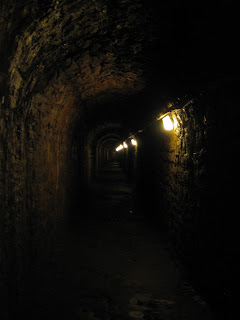This is an article I hope to send into my student newspaper, so it may sound a little different but thought it worth 'blogging':
When embarking on ones first solo trip abroad, the Grand Duchy of Luxembourg isn’t the first place that springs to mind, especially given the relatively expensive nature of this European ‘microstate’. However, it is one of Europe’s best kept secrets and is a three hour train journey from Brussels. It is manageable on a budget thanks to a superb standard of youth hostels and the ‘Luxembourg Card’, which is a ‘must’, giving free entrance to many Luxembourgish attractions and transport. The small capital city, the aptly named, ‘Luxembourg City’, has a population size similar to Wigan’s but packs great charming character with a mixture of Gallic and Germanic influences.
The city is partitioned into four main areas, divided up by the city’s best asset, its dramatic, picturesque setting. The Alzette and Pétrusse rivers cut deep gorges, creating steep cliffs for the medieval fortifications, which are a UNESCO World Heritage site. These protect the ‘Old Town’, which sits on top of a plateau, connected to the rest of the city by impressive viaducts and bridges. The fortifications can be explored through a series of spooky tunnelling casemates. Above ground, the old town clusters around two main squares, the impressive Place Guillaume and the homely Place d’Armes, with trendy restaurants and shops, as well as high quality museums. The Grand Duchy’s Palace is situated here and in the summer is open to the public. The Notre Dame cathedral is equally impressive, outside and inside, although perhaps the most notable site is the Gëlle Fra monument, a golden figure which towers over the city and its gorges.
In the shadow of the fortified centre is the ‘Grund’, a gentrified, chic area which maintains a ‘chocolate box’ Germanic village feel, with greenery and architecture which hugs the river. To the north-east of the city is the ‘Kirchberg’, symbolic of ‘new’ Luxembourg. Although a centre of soulless devotion to European governance and commerce, it is scattered with impressive architecture and contemporary sculptures, and is worth a visit for its political and economic significance, as well as its cultural highlights including the Philiharmonie. The capital encapsulates Luxembourg’s significance as a crossroads of Europe; a surprising, multi-faceted city with a diverse population and heritage. It is a microcosm of ‘Europeaness’, summing up ‘old’ and ‘new Europe’; with the old medieval fortress – the ‘Gibraltar of the North’, through to a new, united Europe, embodied by the Kirchberg.
In many respects this former European City of Culture is ideal for a short break; compact enough to be accessible, combined with charm and many surprises. It means one can get what they would want out of their short stay, whether it be partying, relaxing or sightseeing. It doesn’t have the Colosseum or the Eiffel Tower, but Luxembourg should be one of the first places that springs to mind when going abroad alone for the first time.






No comments:
Post a Comment